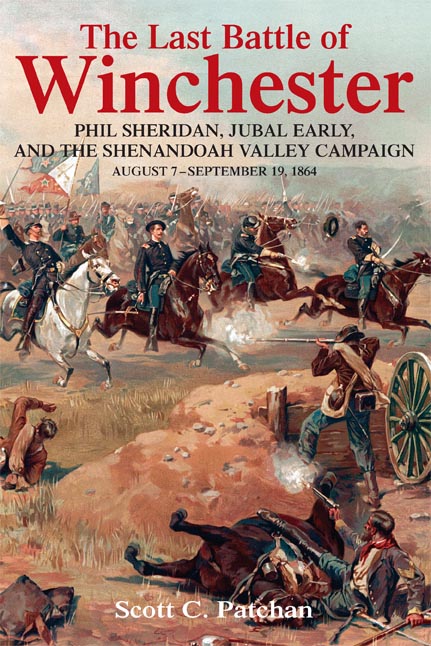Review: The Last Battle of Winchester, Phil Sheridan, Jubal Early, and the Shenandoah Valley Campaign August 7 – September 19, 1864 by Scott Patchan

The Last Battle of Winchester: Phil Sheridan, Jubal Early, and the Shenandoah Valley Campaign, August 7 – September 19, 1864
by Scott Patchin
Savas Beatie LLC, 2013
ISBN 978-1-932714-98-2
553 pp., $34.95
The Shenandoah Valley had always been a theater of operations that the Confederates had held sway. In turn, Confederate victory in the Shenandoah Valley had derailed many a Union generals’ career and multiple times had provoked an invasion of the North.
In 1864, President Abraham Lincoln could not afford another repeat of history. Just that summer a Confederate army under Lieutenant General Jubal Early had used the Shenandoah Valley to invade the North and made it to the gates of Washington D.C. Lincoln, with any hope of being reelected, needed this avenue closed, and permanently.
With the guidance of General Ulysses S. Grant, the Union war effort turned to Major General Philip Sheridan to handle Early’s army and neutralize the valley as a place of food, forage, and fondness for the Confederate war effort.
The beginning of that campaign, chiefly a month and a half, from August to late September 1864, laid the foundation for what came after and bore the seeds that would grow into Union victory and Confederate defeat. This integral time of the campaign is accurately and vividly reproduced in the micro-tactical study completed by renowned Shenandoah Valley military historian, Scott Patchan.
Patchan writes that the importance of the campaign centered around the tactical view from Washington D.C. and that in August 1864 the Shenandoah Valley was in “complete chaos” (pg. 15). Sheridan was brought in because his predecessors, chiefly David Hunter and even George Crook were “not up to the challenge of command” independently in the area (pg, 15).
With changes to the area, including organizational; the melding of four military divisions into one, with all ground forces under Sheridan, there would be a new emphasis to command. Sheridan was ordered, through Grant, to proceed cautiously, as the Lincoln Administration were concerned about another disaster in the Valley. With Grant bogged down at Richmond-Petersburg and Atlanta still eluding William Sherman’s army group, Sheridan was kept on a tight leash for the duration of August.
This portion of the campaign, Patchan relies on the primary sources of the officers and soldiers that donned the blue and gray. This is where the historian is at its best. Bringing forth a multitude of personal accounts, Patchan takes the campaign of maneuver and highlights the strands that will play so prominently later on.
Including some levity, when at the Battle of Crooked Run on August 16th, when a Union paymaster closed up shop so he could “see a battle” (pg. 84).
Capturing with precision, Patchan’s history winds the reader through the first month and a half of the last major campaign in the Shenandoah Valley.
The book concludes with the Third Battle of Winchester and the assessment of the impact of this final battle for the embattled town. If Patchan did a masterful job of weaving the month of smaller engagements and maneuvers up to the battle, he topped that with his concise yet descriptive telling of this battle.
As the engagement began immediately to the west of the Berryville Canyon and preceded after an all-day affair through the town, Patchan intertwines analysis with primary sources to capture the desperate nature of the action. Underscoring the desperation of the Confederate defense, Patchan unearths gems of description including for example the following; Jubal Early, his face aglow with a “look of fierceness” shouting commands in his “never to be forgotten nasal tones” (pg. 253).
Lastly, a small note must be made of the illustrations used. From clear maps, done by Hal Jesperson, to personal photographs that show modern views of the battlefields and the unfortunate loss of battlefield land; i.e. Dinkle farm lane which is now a shopping center, these additions provide great clarification to underscore the writing (pg. 253).
If you are ready to dive into the best of Civil War history in the Shenandoah Valley at the tactical level, this is the book to start with. Patchan writing with years of experience on the ground will carry you through this most pivotal period in the last summer and autumn of the war.
As the publisher, I would like to thank you for taking the time to read the book and leave this thoughtful review. We appreciate it, and I know the author does as well.